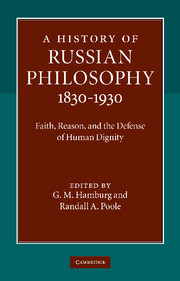Book contents
- Frontmatter
- Contents
- List of contributors
- Acknowledgments
- Introduction: The humanist tradition in Russian philosophy
- I The Nineteenth Century
- II Russian Metaphysical Idealism in Defense of Human Dignity
- III Humanity and Divinity in Russian Religious Philosophy after Solov′ëv
- IV Freedom and Human Perfectibility in the Silver Age
- 11 Religious humanism in the Russian Silver Age
- 12 Russian liberalism and the philosophy of law
- 13 Imagination and ideology in the new religious consciousness
- 14 Eschatology and hope in Silver Age thought
- V Russian Philosophy in Revolution and Exile
- Afterword: On persons as open-ended ends-in-themselves (the view from two novelists and two critics)
- Bibliography
- Index
13 - Imagination and ideology in the new religious consciousness
Published online by Cambridge University Press: 05 June 2012
- Frontmatter
- Contents
- List of contributors
- Acknowledgments
- Introduction: The humanist tradition in Russian philosophy
- I The Nineteenth Century
- II Russian Metaphysical Idealism in Defense of Human Dignity
- III Humanity and Divinity in Russian Religious Philosophy after Solov′ëv
- IV Freedom and Human Perfectibility in the Silver Age
- 11 Religious humanism in the Russian Silver Age
- 12 Russian liberalism and the philosophy of law
- 13 Imagination and ideology in the new religious consciousness
- 14 Eschatology and hope in Silver Age thought
- V Russian Philosophy in Revolution and Exile
- Afterword: On persons as open-ended ends-in-themselves (the view from two novelists and two critics)
- Bibliography
- Index
Summary
From the terrifying distance there sounds a voice of hope – not the hope of a single life, but a universal hope for the potential salvation of humanity from the ugliness and vulgarity of life by means of true, inspirited beauty. Then I look out the window of my monastic cell onto this noisy Petersburg, with its innumerable smoking chimneys, with its damp streets along which crowds rush, and I wonder: where is this ferment of young, still vital forces leading? What road will it find? Will victory be had by the elements that turn the life of the capital into an insufferable soulless turmoil, or will those elemental forces finally prevail which found expression in the prophetic works of the best Russian artists and which periodically glimmer in the moods of individual people who thirst for the highest truth? O, I believe that this inner force will conquer; I believe, I believe.
Akim Volynskii (1861–1926) in 1899VOLOGDA, 1902
An unlikely debate club forms, made possible by the tsarist authorities' questionable policy of allowing internally exiled political opponents to congregate in a single provincial town, where they have little to do save carry on their partisan polemics. Among the Social Democrats gathered here are Nikolai Berdiaev (1874–1948), Aleksandr Bogdanov (1873–1928) and Anatolii Lunacharskii (1875–1933); the Socialist Revolutionaries include writer Aleksei Remizov (1877–1957) and budding terrorist Boris Savinkov (1879–1925).
Keywords
- Type
- Chapter
- Information
- A History of Russian Philosophy 1830–1930Faith, Reason, and the Defense of Human Dignity, pp. 266 - 284Publisher: Cambridge University PressPrint publication year: 2010
- 2
- Cited by



